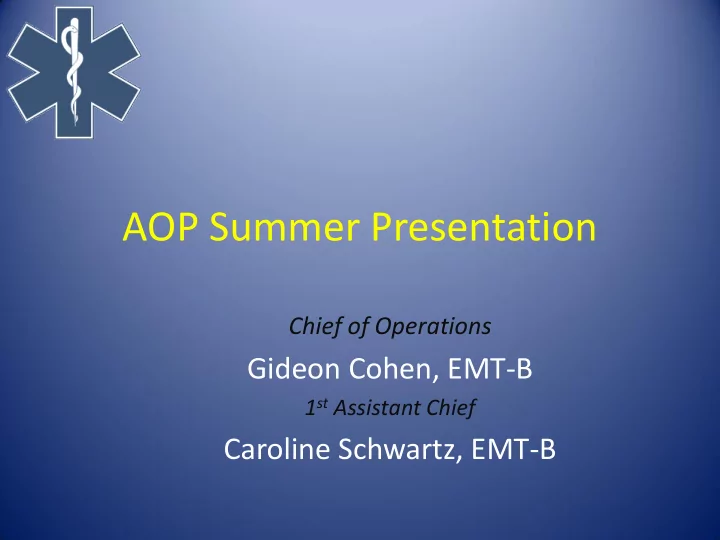

AOP Summer Presentation Chief of Operations Gideon Cohen, EMT-B 1 st Assistant Chief Caroline Schwartz, EMT-B
What to do in an emergency... Call 911
What happens when you call 911? University Police Ambulance Livingston County Scene 911 Fire Dispatch Geneseo First Caller Response UP (245-5222) Paramedic (if needed)
What does 911 need to know? • Your name and a phone number you can be reached at • Your location (Be precise) • What happened to you or the person you are caring for • Age and sex of patient • Patient’s level of consciousness • Known relevant medical conditions
Asthma • Signs and symptoms – Respiratory distress – Shortness of Breath – Wheezing – Chest tightness – Coughing • If left untreated… – Can lead to respiratory arrest or hypoxia (low oxygen levels in the blood)
Asthma • What to do… – Does the person have inhaler? If so, do they have it on them? – Is person calm and in a cool place? – Calm the person down! And encourage the person to take slow, deep breaths (in through nose, out through mouth) – If symptoms are not alleviated by inhaler or inhaler is not present, call 911
Anaphylaxis • Acute allergic reaction • Can be caused by anything we come in contact with – new or old • Symptoms vary widely • If left untreated… – Can result in closing of the airway, respiratory arrest, and ultimately death
Anaphylaxis • Signs and symptoms – Skin: hives, itching, redness, flushed, swelling, blue lips – Respiratory: wheezing (high pitched), shortness of breath, possible hyperventilation – Gastrointestinal: cramps, diarrhea, vomiting • Symptoms may appear immediately or take time, and may be sudden or gradual
Anaphylaxis • What to do… – If person is prescribed EpiPen and person deems it necessary, assist in administering EpiPen and immediately call 911 – Benadryl is NOT sufficient in reversing anaphylaxis – Epinephrine is the same as adrenaline and increases heart and breathing rates – Epinephrine can be dangerous – read instructions on EpiPen to ensure correct administration
Alcohol Poisoning • When in doubt, call for help • Signs and Symptoms – Vomiting – Seizures – Unconsciousness (unable to be roused) – Blue tinged skin or lips – Irregular or slow breathing • People in this condition require advanced medical care
Quick Review of CPR • New American Heart Association Guidelines – Push hard, Push Fast – No breaths if you are not willing – C-A-B instead of A-B-C – Minimize interruptions in compressions – At least 100 compressions per minute
Questions??? • Visit www.geneseo.edu/~esquad for contact information
Recommend
More recommend